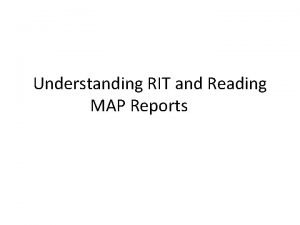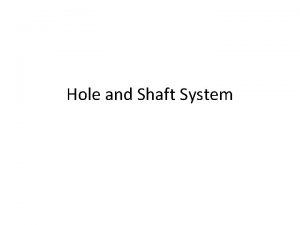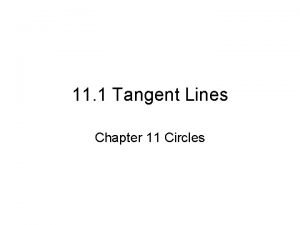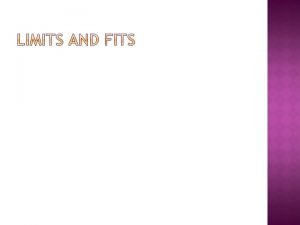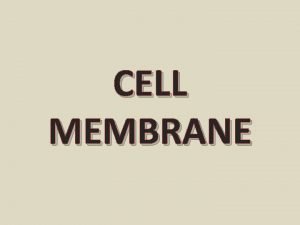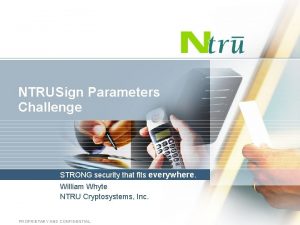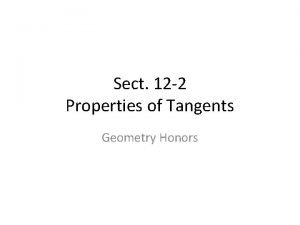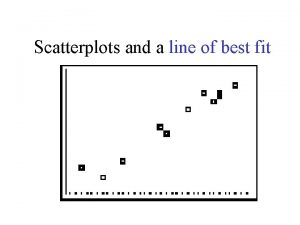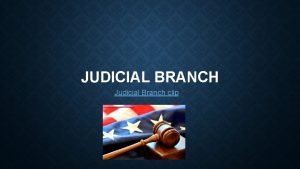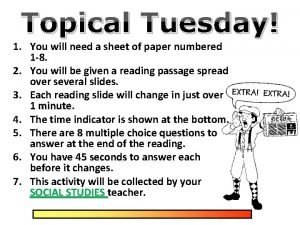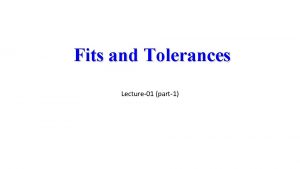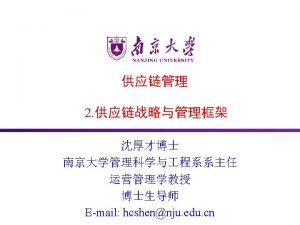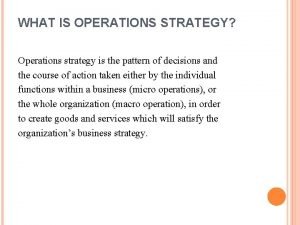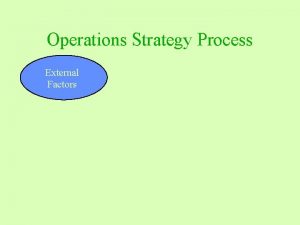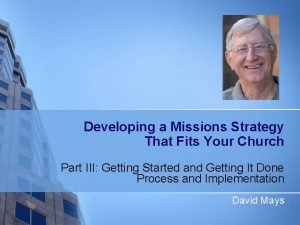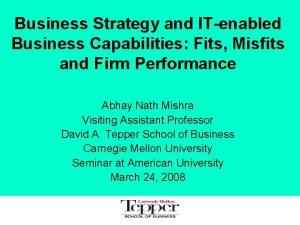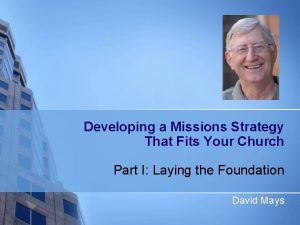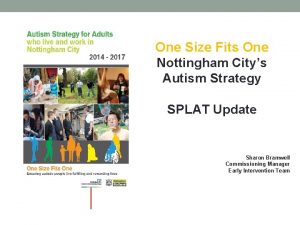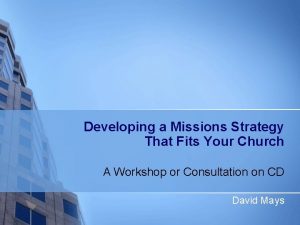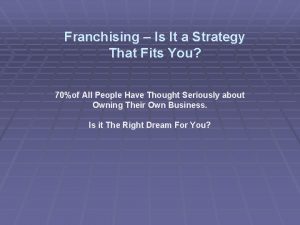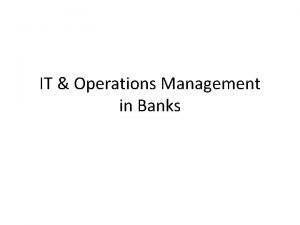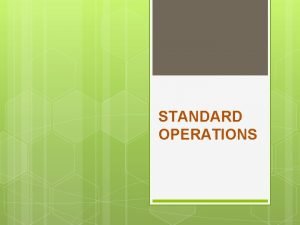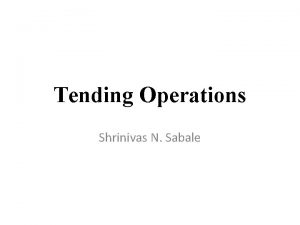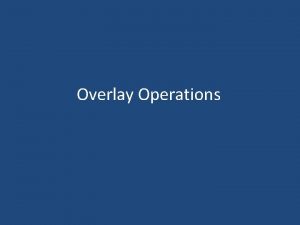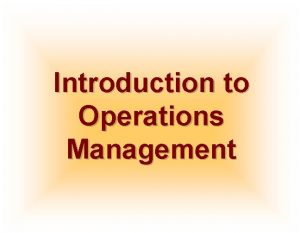Operations Strategy 1 How Operations Strategy fits the



























- Slides: 27

Operations Strategy 1

How Operations Strategy fits the Operations Management Philosophy Operations As a Competitive Weapon Operations Strategy Project Management Process Strategy Process Analysis Process Performance and Quality Constraint Management Process Layout Lean Systems Supply Chain Strategy Location Inventory Management Forecasting Sales and Operations Planning Resource Planning Scheduling 2

Outline 1. Starbucks 2. Operations Strategy 3. Corporate Strategy 4. Customer-Driven Operations Strategy 5. Competitive Priorities and Capabilities 6. New Service or Product Development 7. Operation Strategy as a Pattern of Decisions 3

Starbucks Ø If someone says, “Lets go out for coffee, ” Starbucks often comes to mind. Ø Entrepreneur Howard Schultz had an operations strategy in mind in 1990 when he bought the 17 -store Seattle chain and turned it into a global success. Ø Service strategy was key. Ø Offering a variety of specialized products and services, such as Internet access, phone ahead ordering, and CD burning, all in a socially interactive atmosphere. 4

Operations Strategy Ø Operations strategy is the means by which operations implements the firm’s corporate strategy and helps to build a customer-driven firm. Ø It links long-term and short-term operations decisions to corporate strategy. Ø It is the core of managing processes and value chains. 5

Customer-Driven Operations Strategy Ø Corporate strategy views the organization as a system of interconnected parts, each working with the others to achieve desired goals. Ø Operations Strategy supports the corporate strategy and requires continuous crossfunctional interaction. Ø The operations strategy should be customer driven. 6

Developing a Corporate Strategy Ø Developing a corporate strategy involves three considerations: 1. Monitoring and adapting to the environment 2. Identifying and developing core competencies 3. Developing the firm’s core processes Ø Adapting requires environmental scanning to monitor trends for opportunities and threats. Ø Core Competencies are the unique resources and strengths an organization possesses. 7

Core Competencies Ø Core competencies include… Ø A well-trained and flexible Workforce Ø Having well-located & flexible Facilities Ø Having Market and Financial Know-How. Ø Expertise in Systems and Technology. Ø The core competencies should determine the firm’s core processes. Ø These can include customer relations, new service/product development, order fulfillment, and supplier relationships. Ø A firm may have all of these or focus on a subset of them, as determined by its core competencies. 8

Global Strategies Ø A global strategy may include buying foreign services or parts and entering or expanding foreign markets. Ø Two effective global strategies are: 1. Strategic Alliances a) Collaborative efforts b) Joint ventures c) Technology licensing 2. Locating abroad 9

Market Analysis Ø A Market Analysis is one key to developing a customer-driven strategy, and is accomplished in two parts. Ø Market Segmentation, which identifies groups of customers with enough in common to warrant developing services and/or products for them. Ø Needs Assessment identifies the needs of each market segment. Needs include such things as: Ø Service or product needs Ø Delivery system needs Ø Volume needs 10

Arriving at the Competitive Priorities Corporate Strategy • • environmental scanning core competencies core processes global strategies Market analysis • segmentation • needs analysis Competitive priorities • • cost quality time flexibility 11

Competitive Priorities Cost Quality 1. 2. 3. Time 4. 5. 6. Flexibility 7. 8. 9. Low-cost operations Top quality Consistent quality Delivery speed On-time delivery Development speed Customization Variety Volume flexibility 12

Competitive Capabilities Ø The Competitive Capabilities are the cost, quality, time and flexibility dimensions of competitive priorities that a process or value chain actually possesses and is able to deliver. Ø Low Cost means delivering a service or product at the lowest possible cost to the satisfaction of the customer. 13

Quality as a Competitive Capability Ø Top Quality: Delivering an outstanding service or product. Ø Considerable interaction with the customers may be required to determine what that means. Ø Consistent Quality: Producing services or products that meet design specifications on a consistent basis. 14

Time as a Competitive Capability Ø Delivery Speed is quickly filling a customer’s order. Ø Lead Time is the time between receipt of an order and filling the order. Ø On-Time Delivery means meeting the delivery time promises. Ø Development Speed is quickly introducing a new service or product. Ø Time-Based Competition is a strategy that focuses on development speed and delivery speed. 15

Flexibility as a Competitive Capability Ø Customization means satisfying the unique needs of each customer by changing the service or product designs. Ø Variety involves handling a wide assortment of services or products efficiently. Ø Volume Flexibility requires accelerating or decelerating the rate of production quickly to handle large fluctuations in demand. 16

Northrup Grumman Newport News Ship Building Ø The world’s only producer of full-sized aircraft carriers Ø Long lead times of 8 years or more often involve many changes. Ø Their processes have a high degree of flexibility to handle changes in design. Ø Flexibility in workforce skills as well as process flexibility is necessary. 17

Order Winners and Order Qualifiers Ø These are criteria used by customers in service or product selection. Ø Order Winners are criteria for differentiating services or products of one firm from those of another. Ø Price, quality, time, flexibility, after sales support, reputation, etc. Ø Order Qualifiers are demonstrated levels of performance required to do business in a particular market segment. 18

Service or Product Development Strategies Ø Product Variety: Offering a wide assortment. Ø Design: Ease of use and desirable features. Ø Innovation: Translate new technology into new products. Ø Service: Products with services added. Ø Leader: Being first to introduce new services and/or products. Ø Middle of the Road: Wait for the leaders to introduce new services and/or products. Ø Laggard: Wait to see if the leader’s new services and/or products catch on in the market. 19

Service Package Ø A Service Package is a collection of goods and services provided by a service process to its customers. It consists of four features: 1. Supporting Facility: The physical resources that must be in place before a service can be offered. 2. Facilitating Goods: The materials purchased or consumed by the customer or the items provided by the customer to receive a service. 3. Explicit Services: The readily observable benefits. 4. Implicit Services: Psychological benefits. 20

Quality Function Deployment (QDF) Ø Quality Function Deployment (QDF) is a means of translating customer requirements into the appropriate technical requirements for service or product development. Questions it seeks to answer are… 1. What do our customers want? 2. How well are we doing relative to our competition? 3. What technical measures relate to our customers’ needs? 4. What are the relationships between what our customers want and the technical measures? 5. How does our service or product performance compare to the competition? 6. What are the potential technical trade-offs? 21

“House of Quality” Quality Function Deployment Voice of the Engineer Voice of the Customer Correlations Competitive Analysis Technical Comparison © 2007 Pearson Education 22

Development Process Design Specifications are developed for new services or products Service or product not profitable Analysis A critical review of how it will be produced, resource requirements and capabilities. Need to rethink the idea. Development Cross-functional coordination, process design. Sales & promotion Post-launch review Full Launch 23

Concurrent Engineering Ø Concurrent Engineering brings product engineers, process engineers, marketers, buyers, information specialists, quality specialists, and suppliers together to design a product and the processes that will meet customer expectations. Ø This is an essential cross-functional effort during the service and/or product development phase to insure a timely and well-coordinated process that brings value to the customer. 24

Corporate Strategy and Key Operations Management Decisions Corporate strategy Market analysis Competitive priorities New Service/ Product Development No Yes Performance Gap? Operations strategy Decisions • Managing Processes • Managing Value Chains Capabilities 25

Matching Capabilities to Priorities The table below shows how a credit card division matched their capabilities to their priorities and uncovered gaps in their operating strategy. 26

Case Study 1. Case Study in page 65 of your textbook. 2. Answer the questions. (group) 27
 Rit uid
Rit uid Limit fit tolerance
Limit fit tolerance Hole and shaft basis system
Hole and shaft basis system Practice 11-1 tangent lines
Practice 11-1 tangent lines Strange fits of passion have i known
Strange fits of passion have i known In analytical learning hypothesis fits
In analytical learning hypothesis fits Chapter 11 circles
Chapter 11 circles Limts
Limts What does structure fits function mean
What does structure fits function mean Security that fits everywhere
Security that fits everywhere A belt fits tightly around two pulleys
A belt fits tightly around two pulleys 50f7 tolerance
50f7 tolerance Pictogram for skin burns
Pictogram for skin burns Limits fits and tolerances lecture notes
Limits fits and tolerances lecture notes Types of fit
Types of fit The equation y=12.21x+37.42 fits the scatter plot
The equation y=12.21x+37.42 fits the scatter plot Judicial branch clip art
Judicial branch clip art Which fits best in the empty box above?
Which fits best in the empty box above? đặc điểm cơ thể của người tối cổ
đặc điểm cơ thể của người tối cổ Các châu lục và đại dương trên thế giới
Các châu lục và đại dương trên thế giới Tư thế worms-breton
Tư thế worms-breton ưu thế lai là gì
ưu thế lai là gì Thẻ vin
Thẻ vin Tư thế ngồi viết
Tư thế ngồi viết Bàn tay mà dây bẩn
Bàn tay mà dây bẩn Các châu lục và đại dương trên thế giới
Các châu lục và đại dương trên thế giới Mật thư tọa độ 5x5
Mật thư tọa độ 5x5 Bổ thể
Bổ thể
